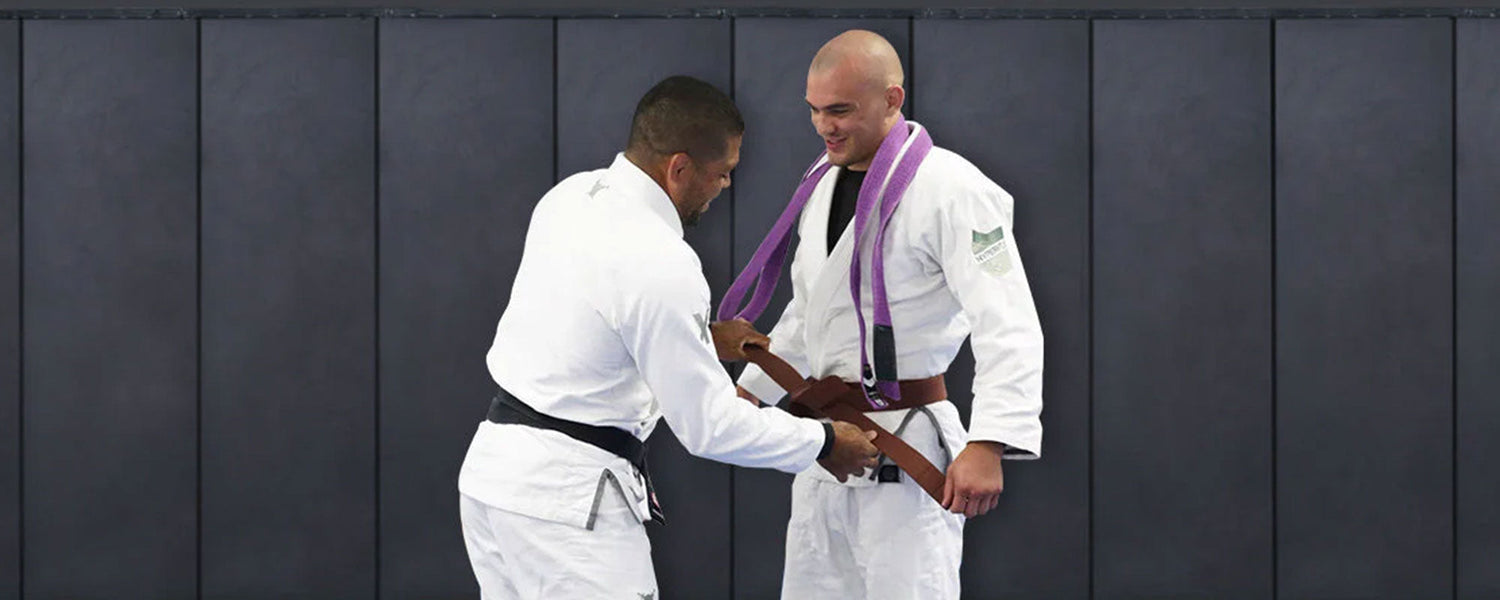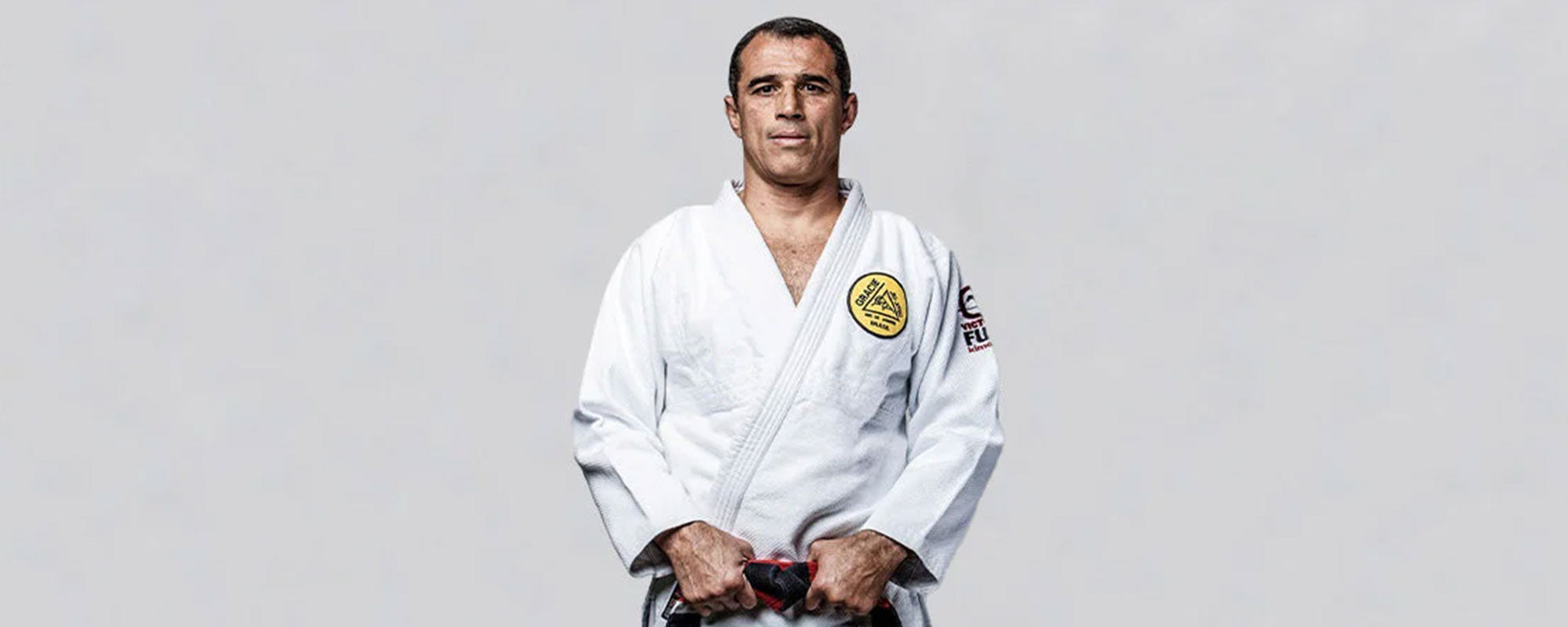Table of content
1. Introduction to Belt Rank System - Purple to Brown
1.1. Purple Belt
Purple belt is the third rank in Brazilian Jiu-Jitsu. Many practitioners consider the purple belt to be the transition stage between a beginner and an expert.
Earning a purple belt is considered to be the midway point of a martial arts student's career and signifies that the student takes Brazilian Jiu-Jitsu seriously, having dedicated a considerable portion of one’s adult life to it.
Being promoted to purple belt, students feel a sense of relief as they have reached the halfway point towards becoming a black belt.
Purple Belt Expectations
An advanced purple belt should be able to perform nearly all basic techniques at the beginning of the course and move on to more advanced techniques.
A student’s time as a purple belt is when they begin training in an advanced style of Brazilian Jiu-Jitsu that best matches their needs, whether they want to perfect the finer nuances of the X-guard or to improve their knee-on-belly techniques.
The transition from blue belt to purple belt is typically the point in a Brazilian Jiu-Jitsu career when the martial art begins to make sense and they are able to concentrate on the minute details that distinguish professionals from amateurs .
Additionally, purple belts should feel confident enough in the fundamental techniques that they are able to teach students basic lessons with the authority and effectiveness of white belts.
Purple belts must know how to:
- Play a dangerous guard game
- Can carry out a number of different combination attacks
- Use advanced guard pass variants (spider, deep-half, de la riva, etc.)
- Execute multiple submissions from any mounting position
- Introduction of leg lock
2. International Brazilian jiu-jitsu Federation(IBJJF)
The IBJJF requires a practitioner to hold a purple belt for a minimum of 18 months before achieving a brown belt.
2.1. Requirements to get into IBJJF as a Purple Belt
To be eligible for a purple belt, the International Brazilian Jiu-Jitsu Federation (IBJJF) requires students to be at least 16 years old and must have spent a minimum of two years ranked as a blue belt.
2.2. Purple Belt Essential Training Techniques
Brazilian Jiu-Jitsu requires a purple belt to take down the opponent in three different ways.
The key component of a purple belt is momentum and movement. At this point, purple belts are seen around with a lot of on top shrimping and spinning while in a guard.
- The fundamentals to rank up from Purple to Brown require knowing how to sweep, mount, control, knee on belly, and guard pass.
| Self-Defense | |
|---|---|
| Quick takedowns | On the ground and standing |
| Strike Evasion | On the ground and standing |
| Standing and ground control | |
| Submissions |
|---|
| Arm triangle (From the back) |
| Armlocks (From Closed Guard, Half Guard, and the Mount) |
| Triangle choke (From Guard, Mount, and Back) |
| Wrist Locks (From both Closed Guard and the Mount) |
| Ezekiel choke (From the Mount) |
| Toe hold |
| Kneebar |
| Darce choke |
| Bow and arrow choke |
| Loop choke (From Half Guard) |
| Guard Pass |
|---|
| Knee Slice Pass |
| Over Under Pass |
| Sao-Paul Pass |
| Folding Pass |
| Leg Drag Pass |
| Closed Guard |
|---|
| Stack Pass |
| Williams Guard |
| Rubber Guard |
| High Guard |
| Closed Guard Sweeps |
|---|
| Guillotine Sweep |
| 100% Sweep |
| Flower Sweep |
| Overheard Sweeps |
| Open Guards |
|---|
| BJJ purple belt requires students to must know how to execute a few different types of Open Guards |
| X Guard (Full X-Guard and Single Leg X-Guard) |
| Spider Guard |
| De la Riva Guard |
|---|
| De la Riva Guard (Regular and Reverse) |
| Half Guards |
|---|
| Half Guard Submissions (Kimura and Loop Choke) |
| Half Guard Sweeps (At least 2) |
Body Positioning
| Side Control |
|---|
| North South (Choke from Side Control) |
| Judo Side Control (From Mount and Back) |
| Twister Side (From Mount and Back) |
| Back Control |
|---|
| Back Retention (From Mount and Back) |
| Switching Sides |
| Body Triangle |
| Knee on Belly |
|---|
| Switching Sides |
| Pressure from Knee on Belly |
| Turtle Attacks |
|---|
| Nelsons |
| Rolling Back takes |
| Front Headlock Attacks |
| The Mount |
|---|
| Low Mount |
| High Mount |
| S-Mount |
| Standing Position |
|---|
| Open Guard Pull |
| Half Guard Pull |
| Single Leg Takedown (Different Finishes) |
| Double Leg Takedown (Different Finishes) |
| Hiza Guruma |
| Kata Guruma |
| Sumi Gaeshi |
| Front Headlock Snapdowns |
| Escapes | |
|---|---|
| Knee on belly | Escape to Leg Locks |
| Turtle Bottom | Rolling Out, Frame Escapes, Half Guard |
| Mount Bottom | Bump Escape, Alcatraz Escapes, Ashi Garami |
| Back Control Bottom | Grip Fighting, Turtle, Body Triangle Escape |
| Side Control Bottom | Rollover, Ghost Escape, Half Guard |
3. Timeline to Promotion
To promote to the next belt, practitioners must have an experience of five to six years in Brazilian Jiu-Jitsu.
4. Purple Belt Test Requirement
On average, five years of training with a minimum of 360 classes plus the test is mandatory to promote to the next belt (Brown).
It is always up to the instructor to promote you to the next belt. To maintain a good position your attendance should be above average, have a good moral attitude in and outside the school, and consistently enthusiastic hard work is required.
Throws and Takedowns
- One leg throw
- Four hip throws
- Two double legs
- Two single legs
Escapes
- Two ways to escape the mount
- Two way to escape the side-mount
- Two way to escape the rear-mount
- Two way to escape the knee-on-belly
Guard Pass
- Five different ways to pass the guard and get side control
Half Guard
- Two Sweeps from Half Guard
- Two Half Guard Passes
Sweeps from the guard
- Three different ways to sweep your opponent
Submissions
- Three from the mount
- One double attack
- Three from the side-mount
- Four from side control
- Three from the back
- Two from the knee in the belly
- Three from the guard
Self Defense
- Two ways to defend the guillotine standing up
- Two ways to defend the headlock standing
- One way to defend the headlock on the ground
- One way to defend the guillotine on the ground
5. Brown Belt
5.1. Tips to Rank Up from Purple to Brown
- Roll with greater smoothness: Experiment with techniques and keep learning new knowledge about difficult positions and guards.
- Manipulate your opponent: Learn to manipulate your opponent’s weight to your advantage.
- Focus on the right techniques: Eliminate superfluous actions and reduce wasted movements.
- Get committed to your timings: Work on your defense and spend time covering your weaknesses.
- Patience: You may have to spend a majority of your time perfecting the techniques you are not good at and it is totally normal. All the elite fighters once had to go through these struggles.
- Movement and momentum: Gain high efficiency and a stronger understanding of momentum and weight.
- Importance of Guard in Purple Belt: Be familiar with every guard form and specialize in executing two perfectly.
6. Frequently Asked Question
6.1. How Long Does It Take to Get a Purple Belt?
6.2. Why is the Purple Belt Rank so Important?
A BJJ practitioner joins the purple belt training sessions with basic jiu-jitsu knowledge acquired at the blue belt phase. The practitioner trains at this level for a minimum of two years and during this time he/she gets to perfect the BJJ skillset. Most BJJ practitioners develop their unique BJJ strategy as a purple belt and set a trajectory for their brown belt training phase. In other words, the purple belt training decides ones future in BJJ and for this reason it is a critical phase in every BJJ enhusiast’s life.
Photo Credit: @dcdeangelis












Leave a comment
This site is protected by hCaptcha and the hCaptcha Privacy Policy and Terms of Service apply.